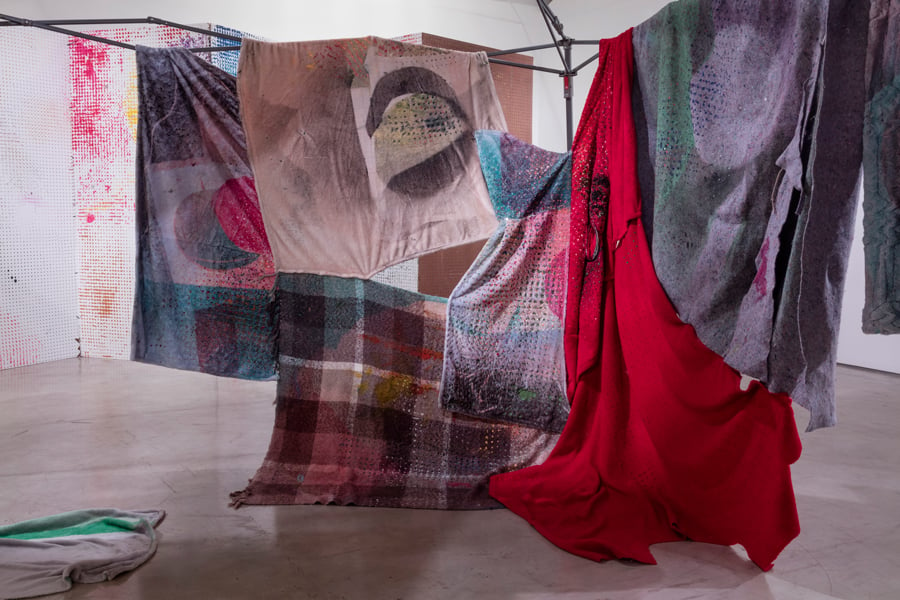
Every year thousands of young artists in the early stages of their career help shape the dynamic and constantly changing landscape of contemporary art.
Here we collect a selection of the most talented newcomers from around the world. Working in an array of different mediums, the artists all have very distinct and diverse practices and visual languages, each with the potential to shape the future of contemporary art.
Pedro Wirz, Ovo por Olho (Killian) (2016). Photo: courtesy of the artist.
1. Pedro Wirz
Nobody is making work that looks like the Swiss-Brazilian artist’s fantastical installations. His use of material blends natural elements such as wood, tree bark, wax, and soil with plastics such as latex, epoxy resin, and silicone. Wirz’s work explores the fine line between fiction and reality, and is strongly influenced by folklore, popular superstitions, and how mythology connects people around the globe.
Corydon Cowensage Stairs #3 (2016). Photo: courtesy Miller Contemporary, New York.
2. Corydon Cowansage
Straddling the space between geometric abstraction and representational biophilia, the Philadelphia-born painter’s vibrantly colored canvases subtly reference the human body to expose the relationship between man and nature. The artist’s canvases incorporate a meditative use of grid-like structures, which are subverted by her inclusion of plant-like forms and saturated tones.
Lydia Ourahmane p.H. 8.7 (2015). Photo: courtesy of the artist.
3. Lydia Ourahmane
Mixing readymades, installation, video, and performance the Algerian-born British multidisciplinary artist explores her ideas through a variety of mediums, but the message is the same. Her work revolves around the struggle for identity in a globalized world, at the intersection of cultures and “transitional existences.”
Austin Lee Dropsy (2013). Photo: Postmasters Gallery.
4. Austin Lee
The artist’s semi-figurative post-internet aesthetic investigates the space between the physical and digital brushwork. Lee’s work leans heavily on computerized processes such as iPad drawings and Photoshop manipulations, which he combines with acrylic painting. Characterized by heavily saturated color tones, the artist’s blurry, cartoonish figures appear both distinctly familiar and totally foreign at the same time.
Todd Bienvenu Underboob (2016). Photo: courtesy of the artist and yours mine & ours.
5. Todd Bienvenu
Creating candid yet humorous paintings, Bienvenu tackles the realities of contemporary culture from a refreshing and decidedly unpretentious standpoint. Portraying themes such as sex, drinking, and rock ’n roll in a thick, painterly style, the artist explores lowbrow popular culture from a highbrow perspective.
Landon Metz. Installation view “Morris Louis/Landon Metz” (2016) at Paul Kasmin Gallery, New York. Photo: courtesy of Paul Kasmin Gallery, New York.
6. Landon Metz
A contemporary proponent of color field painting, the artist’s sparse carefully stained canvasses recall the legacy of Morris Louis or Helen Frankenthaler. Thematically, the artist’s paintings deal with the concept of infinity, with many of the works acting as continuations of each other when displayed side-by-side. Recently, Metz’s work has taken an extra turn towards the experimental, exploring the use of shaped canvases and spatial interventions.
Melike Kara, state of wakeful sleep (Stillleben) (2016). Courtesy of Peres Projects.
7. Melike Kara
Known for her sparse yet energetic pastel-colored, figurative paintings, the young German artist portrays groups of complex anatomical shapes with ambiguous, undefined faces. Often resembling drawings, Kara’s minimalistic canvases are characterized by unrehearsed and improvised-looking brushstrokes. Thematically, the works approach sexuality and the complex relationship between humanity and the natural world in a number of ways that get people talking.
Elaine Cameron-Weir. “Erotix” installation view at Andrea Rosen Gallery (2016). Photo: Andrea Rosen Gallery via Facebook.
8. Elaine Cameron-Weir
The Canadian artist’s work focuses on multi-medium and assemblage-based sculptures with undertones of alchemy and chemistry. Characterized by an eccentric selection of materials ranging from lead, sand, frankincense, and readymades such as neon lighting, Bunsen burners, and pulleys, Cameron-Weir’s take on sculpture references the past but remains uniquely contemporary.
Peles Empire Remnant 2 (2016). Photo: Wentrup Gallery via Facebook.
9. Peles Empire
The Berlin-based duo consisting of artists Katharina Stöver and Barbara Wolff have been working together under the name Peles Empire since 2005. Their work revolves around the Peleș Castle, a summer residence of the Romanian royal family built at the turn of the 20th century. By producing abstracted replications of individual components of the structure the artists break down themes such replication, copying, in a critique of the homogenization of contemporary culture.
Eric Mack Tent (2015). Photo: Courtesy of the artist.
10. Eric Mack
Incorporating found objects on painted wall-mounted fabrics and quilts, the New York-based artist’s work leans on the legacy of Abstract Expressionism but reinterprets it in a contemporary way. Mack seeks to present painting as an object rather than a two-dimensional surface, via splattered wall-draped carpets and tent-like structures that create immersive painted environments.